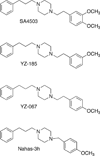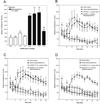N-phenylpropyl-N'-substituted piperazines occupy sigma receptors and alter methamphetamine-induced hyperactivity in mice
- PMID: 27851908
- PMCID: PMC5244969
- DOI: 10.1016/j.pbb.2016.11.003
N-phenylpropyl-N'-substituted piperazines occupy sigma receptors and alter methamphetamine-induced hyperactivity in mice
Abstract
This study examined the effect of the N-phenylpropyl-N'-substituted piperazine ligands SA4503 (3.4-dimethoxyphenethyl), YZ-067 (4-methoxyphenethyl), YZ-185 (3-methoxyphenethyl) and Nahas-3h (4-methoxybenzyl) on methamphetamine-induced hyperactivity in mice. In a previous study in rats, SA4503 increased methamphetamine-induced hyperactivity at a lower ligand dose and enhanced it at a higher dose. The other ligands have not been investigated in this assay. Presently, mice were administered sigma ligands, and specific [125I]E-IA-DM-PE-PIPZE and [125I]RTI-121 binding was measured to determine σ1 sigma receptor and dopamine transporter occupancy, respectively. Mice were also administered sigma ligands followed by methamphetamine, and locomotor activity was measured. Each of the ligands occupied σ1 sigma receptors (ED50=0.2-0.6μmol/kg) with similar potency, but none occupied the transporter (ED50>10μmol/kg). At the highest dose tested (31.6μmol/kg) all four sigma ligands significantly attenuated methamphetamine-induced hyperactivity. Interestingly, SA4503, YZ-067 and Nahas-3h, but not YZ-185, enhanced methamphetamine-induced hyperactivity at lower ligand doses (1-3.16μmol/kg). These results suggest that these ligands function as stimulant agonists at lower doses and as antagonists at higher does, with subtle changes in the substitution pattern at the 3- and 4-positions of the phenethyl group contributing to the nature of the interactions. Overall, these data indicate a complex role for σ1 sigma receptor ligands in methamphetamine's behavioral effects.
Keywords: Behavior; Dopamine transporter; Locomotor activity; Methamphetamine; Mouse; Receptor occupancy; Sigma receptor.
Copyright © 2016 Elsevier Inc. All rights reserved.
Conflict of interest statement
Statement The authors have no other funding sources or conflicts of interest to report.
Figures







Similar articles
-
The sigma receptor ligand N-phenylpropyl-N'-(4-methoxyphenethyl)3piperazine (YZ-067) enhances the cocaine conditioned-rewarding properties while inhibiting the development of sensitization of cocaine in mice.Psychopharmacology (Berl). 2020 Mar;237(3):723-734. doi: 10.1007/s00213-019-05411-z. Epub 2019 Dec 10. Psychopharmacology (Berl). 2020. PMID: 31822924
-
Effects of N-phenylpropyl-N'-substituted piperazine sigma receptor ligands on cocaine-induced hyperactivity in mice.Pharmacol Biochem Behav. 2013 Sep;110:201-7. doi: 10.1016/j.pbb.2013.07.006. Epub 2013 Jul 24. Pharmacol Biochem Behav. 2013. PMID: 23891829
-
Cocaine occupancy of sigma1 receptors and dopamine transporters in mice.Synapse. 2016 Mar;70(3):98-111. doi: 10.1002/syn.21877. Epub 2015 Dec 24. Synapse. 2016. PMID: 26618331 Free PMC article.
-
1-(4-[18F]Fluoromethoxy-3-methoxyphenethyl)-4-(3-phenylpropyl)piperazine.2007 Jun 7 [updated 2008 Feb 6]. In: Molecular Imaging and Contrast Agent Database (MICAD) [Internet]. Bethesda (MD): National Center for Biotechnology Information (US); 2004–2013. 2007 Jun 7 [updated 2008 Feb 6]. In: Molecular Imaging and Contrast Agent Database (MICAD) [Internet]. Bethesda (MD): National Center for Biotechnology Information (US); 2004–2013. PMID: 20641235 Free Books & Documents. Review.
-
Could sigma receptor ligands be a treatment for methamphetamine addiction?Curr Drug Abuse Rev. 2010 Sep;3(3):156-62. doi: 10.2174/1874473711003030156. Curr Drug Abuse Rev. 2010. PMID: 21054260 Review.
Cited by
-
The sigma receptor ligand N-phenylpropyl-N'-(4-methoxyphenethyl)3piperazine (YZ-067) enhances the cocaine conditioned-rewarding properties while inhibiting the development of sensitization of cocaine in mice.Psychopharmacology (Berl). 2020 Mar;237(3):723-734. doi: 10.1007/s00213-019-05411-z. Epub 2019 Dec 10. Psychopharmacology (Berl). 2020. PMID: 31822924
-
Pharmacological Treatments for Methamphetamine Use Disorder: Current Status and Future Targets.Subst Abuse Rehabil. 2024 Aug 30;15:125-161. doi: 10.2147/SAR.S431273. eCollection 2024. Subst Abuse Rehabil. 2024. PMID: 39228432 Free PMC article. Review.
-
The sigma-1 receptor as a regulator of dopamine neurotransmission: A potential therapeutic target for methamphetamine addiction.Pharmacol Ther. 2018 Jun;186:152-167. doi: 10.1016/j.pharmthera.2018.01.009. Epub 2018 Jan 31. Pharmacol Ther. 2018. PMID: 29360540 Free PMC article. Review.
References
-
- Desai RI, Kopajtic TA, French D, Newman AH, Katz JL. Relationship between in vivo occupancy at the dopamine transporter and behavioral effects of cocaine, GBR 12909 [1-{2-[Bis-(4-fluorophenyl)methoxy]ethyl}-4-(3-phenylpropyl)piperazine], and benztropine analogs. J Pharmacol Exp Ther. 2005;315:397–404. - PubMed
-
- Fujimura K, Matsumoto J, Niwa M, Kobayashi T, Kawashima Y, In Y, Ishida T. Synthesis, structure and quantitative structure-activity relationships of sigma receptor ligands, 1-[2-(3-4-dimethoxyphenyl)ethyl]-4-(3-phenylpropyl) piperazines. Bioorg. Med. Chem. 1997;5:1675–1683. - PubMed
-
- Fujiwara S, Kuribara H, Tadokoro S. Effects of repeated administration of pentazocine on ambulatory activity in mice: comparison with the effects of morphine and methamphetamine. Jpn J Pharmacol. 1990;54:61–67. - PubMed
MeSH terms
Substances
Grants and funding
LinkOut - more resources
Full Text Sources
Other Literature Sources
Medical

